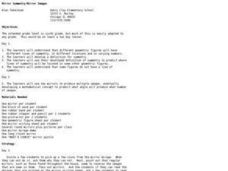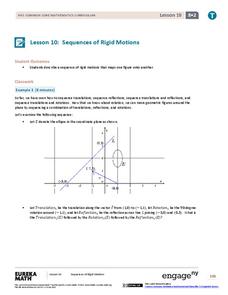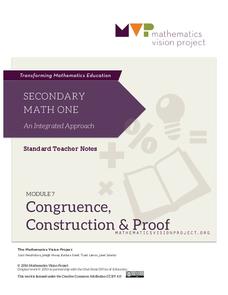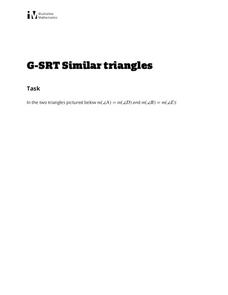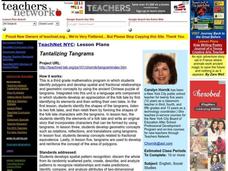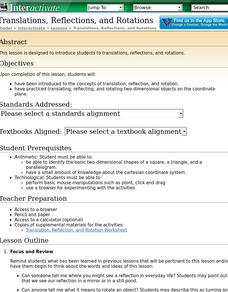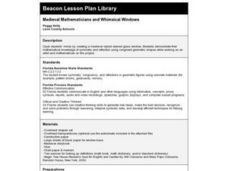Curated OER
Geometric Transformations
This PowerPoint provides opportunities for students to explore geometric transformations. Students examine the position of figures in several photographs and identify each pair as reflections, rotations, or translations.
Curated OER
Flips, Sides and Turns: Exploring Transformations
Students use an online dictionaries to define key geometric terms. They explore several websites to help them differentiate the terms reflections, translations and rotations as they apply to geometry and then complete an assessment...
Curated OER
Geometry: Tessellations
Students create tessellations with computer software while applying their knowledge of reflections, rotations, and translations.
Curated OER
Mirror Symmetry/Mirror Images
Students explore lines of symmetry in geometric shapes. In this geometry lesson, students construct angles using mirrors and rubberbands, then predict the number of images that will appear in the reflection. Students reproduce lines of...
Curated OER
Transformations in the Coordinate Plane
Your learners connect the new concepts of transformations in the coordinate plane to their previous knowledge using the solid vocabulary development in this unit. Like a foreign language, mathematics has its own set of vocabulary terms...
EngageNY
Sequences of Rigid Motions
Examine the various rigid transformations and recognize sequences of these transformations. The lesson asks learners to perform sequences of rotations, reflections, and translations. Individuals also describe a sequence that results in...
Mathematics Vision Project
Congruence, Construction and Proof
Learn about constructing figures, proofs, and transformations. The seventh unit in a course of nine makes the connections between geometric constructions, congruence, and proofs. Scholars learn to construct special quadrilaterals,...
EngageNY
Four Interesting Transformations of Functions (Part 3)
Continue the study of transformations with an examination of horizontal stretches, shrinks, and reflections. Individuals use the same process used in parts one and two of this series to examine horizontal changes. The resource also...
Illustrative Mathematics
Similar Triangles
Proving triangles are similar is often an exercise in applying one of the many theorems young geometers memorize, like the AA similarity criteria. But proving that the criteria themselves are valid from basic principles is a great...
Curated OER
Tantalizing Tangrams
Students identify polygons and develop spatial and fractional relationships and geometric concepts by using ancient Chinese puzzle of tangrams. They develop an appreciation of the folktale by identifying its elements and then writing...
Curated OER
Identifying Lines of Symmetry and Creating Reflections over a Line
Fifth graders review the concept of a line of symmetry by using pieces of paper that have pictures such as, letters of the alphabet, polygons, and designs made from polygons in order to determine if they have symmetry. The fine, two-hour...
Curated OER
Translations, Reflections, and Rotations
Tenth graders have been introduced to the concepts of translation, reflection, and rotation, and have practiced translating, reflecting, and rotating two-dimensional objects on the coordinate plane.
Curated OER
Translations, Reflections, and Rotations
High schoolers are introduced to the concepts of translation, reflection, and rotation. They practice translating, reflecting, and rotating two-dimensional objects on the coordinate plane. students use computers to learn about the three...
Curated OER
Transformation, Reflections, Rotations and Translations
Students create a quilt, using different patterns. For this geometry lesson, students apply prior knowledge as they use different patterns to help them create a quilt using transformations and geometric shapes.
Bowland
Pointzero: Confined
Groups plan their escape carefully. Three three-tiered puzzles help a story character escape their situation, each involving integer sequences, transformations, and geometric constructions. The teacher resource includes slides and...
EngageNY
Mid-Module Assessment Task - Precalculus (module 1)
Individuals show what they know about the geometric representations of complex numbers and linearity. Seventeen questions challenge them to demonstrate their knowledge of moduli and operations with complex numbers. The assessment is the...
Curated OER
Twists and Turns
Students reflect, rotate, translate, and dilate figures in the Cartesian coordinate plane using grid paper and dot paper. They use transformations (i.e., reflections, translations, rotations, and dilations) to describe geometric patterns...
Curated OER
The Geometry of Indigenous Art
Learners examine the concepts of symmetry, rotations, reflections, translation, dialations, and tessellations and apply them to indigenous art. They also do Internet research and create artwork (painting, pottery, computer graphic design).
Curated OER
Medieval Mathematicians and Whimsical Windows
Third graders demonstrate their mathematical knowledge of symmetry and reflection using congruent geometric shapes while working as an artist and mathematician looking at a medieval-styled stained glass window.
Curated OER
Making Shapes
Tenth graders construct geometric figures using compasses and protractors.
Curated OER
Effect of Transformations on Coordinates
In this effect of transformations on coordinates worksheet, learners determine the coordinates of 4 geometric shapes on a grid after a given transformation.
Curated OER
Symmetry of Road Signs
Students identify symmetry in road signs. In this geometry instructional activity, students explore objects in the real world for symmetry. They perform translation, rotation and reflection.
IMSA
Geometric Transformations with Matrices
In this math worksheet, learners find the values associated with the geometric transformations. They read the instruction sheet for completing matrices with translations, rotations, reflections, and scaling by adding and multiplying...
Curated OER
Reflections (2)
In this graphing worksheet, students focus on reflections. Students use rotations to create 6 geometric figures that are represented on the x or y axis.





